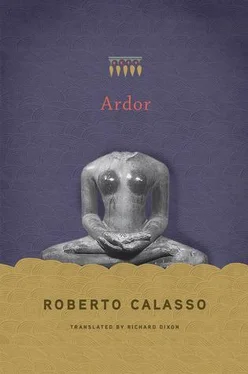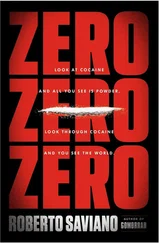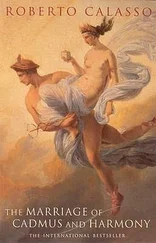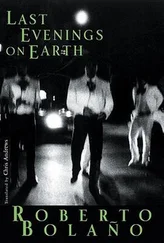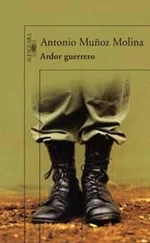* * *
Certain filters, called pavitra , are essential in worship — either two kuśa blades, used for purifying water, or two strips of white wool, used for the soma. Their use recalls the cosmic drama between Vṛtra and Indra. Vṛtra’s nature was that of covering ( vṛ- ), enveloping, enclosing within him, obstructing every “evolution,” a word that in Sanskrit corresponds with pravṛtti , the word that indicates life being lived. This monstrum par excellence, since he held everything within himself, also held supreme knowledge — the Vedas — and soma , the intoxicating drink. For Indra, killing him meant not only making life possible, but also conquering what could make life inextinguishable: knowledge. And it also meant that the waters flowed, brimming over into the world, where they produce the surplus that is life itself. Yet, even though Indra’s gesture implied salvation, it was also a guilty act, one of immense guilt, commensurate with the enormity of his victim. The first sign of guilt is the impurity that has poured into the world since then, through Vṛtra’s wound. This liquid is precious but also putrid. And it is enough to contaminate everything, except for those waters that rose up in disgust to escape evil contact, becoming kuśa grass. The waters, though immediately contaminated, at the same time escape impurity — at least in part. So they will be used to sprinkle, and then consecrate, every element. And here a subtle theological problem appears: how can those who have not been consecrated consecrate? This too is a guilt for which the officiant “makes amends”: already a first sign that guilt extends up to the peak of purity.
The presence of filters enables us to understand that the world is an impure mass. If this were not so, it would not be alive, but would still be closed up in Vṛtra’s vast belly. Now, when even the waters are suspect, since they are in part contaminated, what will allow the return to purity? The world has to be filtered , in the same way that the prodigious soma has to be filtered, which otherwise would not be tolerable. And here is a crucial step: the only element that can provide help, in this scenario of a cosmic swamp, is the stirring breeze. The wind that “blows purifying ( pavate )” corresponds with the two blades of grass that filter, pavitra : but why are there two blades of grass but only one wind? Here follows another decisive step for Vedic theology: there are two filters because there are two basic breaths (inhaled and exhaled), which, by entering the body and leaving it, make it live. So the wind is those breaths and those breaths are the two filters of kuśa grass. This dazzling equation introduces the supreme function of breath (from which the whole of yoga and countless reflections on breathing follow) and explains why the world, this formless and fetid mass of elements where the liquid held in Vṛtra’s wounded body continues to flow even today, needs a breath of wind to filter it, to give life to it, to make it usable in a ceremonial act.
* * *
In the beginning, the gods lost the soma ; men did not have it. But they both found themselves performing the same gestures when they recovered it (or bought it): practicing tapas , fasting — with ever greater rigor. In the meantime, men as well as the gods “heard its sound,” the sound of soma. What was this sound for the gods? We are not told. But we know what it was for people. The sound of the lost soma said: “On such and such a day the buying will take place.” For the gods, an undefined sound; for men, the announcement of an exchange, a sale. This is the passage from divine to human: abrupt, curt. But we are made to understand that, without exchange, man does not exist. Or, at least, he can never obtain soma. As for immortality, it would be naïve to think that for men it may mean an endless duration. So it is made clear: “This assuredly is immortality for man: when he attains a full life.” The most important thing for man is to give form to life, making it whole, perfect, in the same way that the fire altar must be whole, perfect. There is no answer to the question that worried Prajāpati’s creatures: does the perfect life include Death in it? On this there is no answer, either positive or negative.
* * *
The “comedy of innocence” is just the same for the bear about to be killed by hunters as it is for Soma. When the stones are on the point of striking the stalks of the divine plant to bring out the juice, the intention to kill must be directed toward any enemy or being that is hated. Then the sacrificer can say: “Here I strike x , not you.” The guilt therefore resides not in the act — the killing of Soma — but in the mental picture accompanying it. And if the sacrificer has no enemies? If he hates no one? Then he directs this thought, with hatred, to a blade of straw: “If he hates no one, he can even think of a straw, and thus no wrong is incurred.” Corollaries: the act is a necessity, an inevitable step. And it is in itself a guilty act. But anyone who doesn’t want to increase his own guilt, which belongs already to the fact of existing, has to separate their mind from the act, to direct it toward an object that mitigates the guilt. The straw indicates that we are approaching the nonexistent and the invisible. Does anything exist beyond the straw? The detachment that Kṛṣṇa will teach Arjuna in the Bhagavad Gītā , the nonadherence to the act. This is one step higher than simply diverting the act onto another object.
* * *
“And he [Soma], insofar as he is generated, generates him [the sacrificer]”: a phrase that rings out three times. It touches on a delicate and crucial point: mutual procreation. A general rule among the gods, it now finds a ritual counterpart. Nothing exists in itself, all is the result of work. Likewise for soma : the plant from the heavens does not exist until it is pressed, filtered, and sprinkled by the sacrificer and by the priests. But, at the point when soma comes into being, it produces the sacrificer. The existence of the soma brings about a transformation in the person who with his actions has brought it into being.
And at the end of the ceremony, in the same way that King Soma is a bundle of crushed stalks, reduced to a “body unfit for offering,” so too the sacrificer, tired out, a shadow of his former self, makes his way toward the water that flows just below the sacrificial ground. There the cleansing bath, avabhṛtha , awaits him. The soma and the sacrificer: both yearn for new sap. They want to immerse themselves in the water, to forget.
“Thereupon both [the sacrificer and his wife], having gone down, bathe, and wash each other’s back. Having wrapped themselves in fresh clothing, they leave: like a snake that sloughs its skin, so he frees himself from all evil. In him there is no more guilt than in a toothless babe.”
Anyone entering the rite is burdened with gestures, acts, and karman , which literally means “ritual action.” There is no doubt: he sees the light, immortality, he touches the gods. But at the end he nevertheless wants to forget, exhausted. He wants to return to dull, insignificant, straightforward normality. And the sacrificer and his wife retrace the steps they took to arrive at the sacrificial site. They bathe in flowing water. The objects used in the sacrifice are thrown into the water, as if no one wanted to remember they ever existed. Everything must now be new. The innocence of the newborn child is never something given. On the contrary, it is hard fought for. And is short-lived. For the action immediately starts all over again. And the action, every action, and above all that sacred action that makes it possible to attain the light through soma , is a form of guilt. Not because it hurts or injures someone or something, even if it inevitably does hurt and injure, but simply because it is action. On the other hand, without that action any life is formless and empty. But from time to time we need to return to that formlessness, that meaninglessness, because we do not bear too much meaning, too much light, or too much guilt. The sacrificer no longer wears his own clothes. They too are part of an episode now swallowed up. But how will he dress, now? He covers himself with the cloth in which the soma stalks had been wrapped, in which they had appeared in the distant past, a few hours earlier, when the soma had still to be pressed. Tied around his wife is the cloth that had wrapped the cloth in which the soma lay. Then they leave, silently, passively, cleansed, empty. All that remains is a barely discernible fragrance — perhaps discernible only to them — coming from the two cloths in which the soma had for some time been kept.
Читать дальше
